Globex Acquires Major Historic Silver Mining District In Germany
When investors think about mining in Europe, they will most likely end up with an image of gold or silver mines in the Middle Ages when those particular commodities were used as currency. Globex Mining Enterprises Inc. (TSX:GMX – $0.52 & OTCQX:GLBXF – $0.44 & Fra:G1MN – €0.36) on the other hand sees a 21st century investment opportunity.
Just this week, the predominantly North America focused exploration and development project generator announced that it acquired a 5-year exploratory license for a major silver mining district in the state of Saxony in Germany (see location map at bottom).
The area, connected to the well-known Freiberg Mining Field, is roughly 164 square kilometers large and consists of numerous previously active mining projects, with some dating back to the 12th century. Throughout its history, one particular area called Bräunsdorf (see image below), has yielded at least 882 tonnes of silver (worth more than US $500 million at current prices) at high-grades and relatively shallow levels.
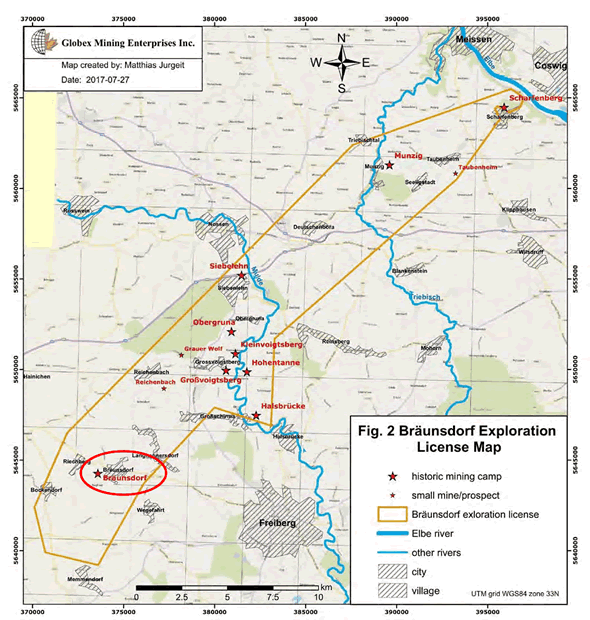
Even though the area was alternately active or inactive for around 750 years, Globex sees a clear opportunity. The main reason for this is that Bräunsdorf was never thoroughly explored nor modernly explored. Be it for obvious technological limitations or economic reasons, some of the mines were never revisited with modern technology and know-how. Given the quality of the previous deposits, this makes the area very attractive.
By compiling the historical data, the Company has already identified perspective areas where silver deposits may be found. On top of that, it is possible that the area may also be rich in other metals or minerals, such as graphite, zinc, lead, barite, tin and fluorite some of which were mined in the past.
In the coming months, the Company will perform several initial research steps on top of the compilation work already done, which could lead to airborne and ground geophysical surveys or even a core drilling program next year.
All in all, this German project significantly strengthens Globex’ already attractive massive property portfolio.
Further Diversification
Globex, as a successful ‘project generator’, is offering investors exposure to the junior mining sector in a unique way as the Company has an interest in, or outright owns, over 150 projects across the base metal, precious metal, industrial minerals and specialty elements spectrum. This way, the Company can weather any commodity crisis and allows shareholders to benefit once the cycle turns without the risk of ‘blowing up’ because of one or two unsuccessful projects.
The Bräunsdorf license is only increasing this aspect further. Not only because it adds several potential projects that can eventually be monetized, but also because it is based in a different geography to the one where most of Globex’ projects are located (Abitibi Belt, Canada). This allows the Company to tap into a whole new market.
The new project is also consistent with the Company’s strategy regarding operating projects being located in countries with a stable legislature, which supports the downside protection of Globex’ operations. The European Union could even be highly supportive of Globex’ efforts due to several recent directives that aim to better utilize the raw materials found within the union.
Europe & Bräunsdorf – A Rare Opportunity
As mentioned, Germany, or Europe, is not the usual place where mining companies currently look for opportunities. The entire continent was heavily explored for its commodity potential in past centuries, and thus could lead to the assumption that whatever is left is likely not worth pursuing be it for the cost of the project or the lack of deposit potential. Although this might be generally true, that perception also created the very opportunity on which Globex can now capitalize.
Often, mining projects were abandoned for technological limitations (both on the production and exploration side), that don’t hold true today. As an example from the Bräunsdorf area, the Munzig Mine Camp, was shut down just because of a water supply problem in the early 19th century. The same is unlikely to be an impediment in today’s world.
Another example is the overburden (commonly found on 90% of the Bräunsdorf area) that prevented exploration activities in the past but which presents less of a challenge nowadays. Furthermore, there could even be significant deposits of minerals that were not interesting for mining companies in the past. In the case of Bräunsdorf, it is possible that there is a potential for a graphite deposit which was never previously explored.
Overburden (also called waste or spoil) is the material that lies above an area that lends itself to economical exploitation, such as the rock, soil, and ecosystem that lies above a coal seam or ore body. Overburden is removed during surface mining, but is typically not contaminated with toxic components and may be used to restore an exhausted mining site to a semblance of its appearance before mining began.
The second reason for abandoning a mine that might not hold true today could be the economic argument. Over the past 100 years silver had its fair share of ups and downs as seen on the chart below and thus in many of the past decades exploration or production was not economically feasible.
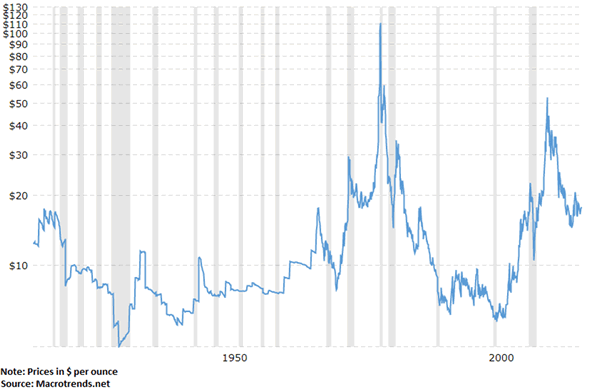
Moreover, the Bräunsdorf area was also behind the ‘iron curtain’ until 1989 as it was part of Eastern Germany where capital for exploration was limited and politics did not create an attractive environment.
All these factors combined explain why so little exploration was conducted on these properties over the past decades, and why Globex now has the opportunity to reveal their hidden value.
Project Highlights
While Globex’ property contains several interesting areas, the Company already identified one zone which deserves plenty of attention. It is a roughly 7 km (4.35 miles) stretch of land between two of the historical mining projects (Bräunsdorf and Großvoigtsberg) as highlighted below in purple.
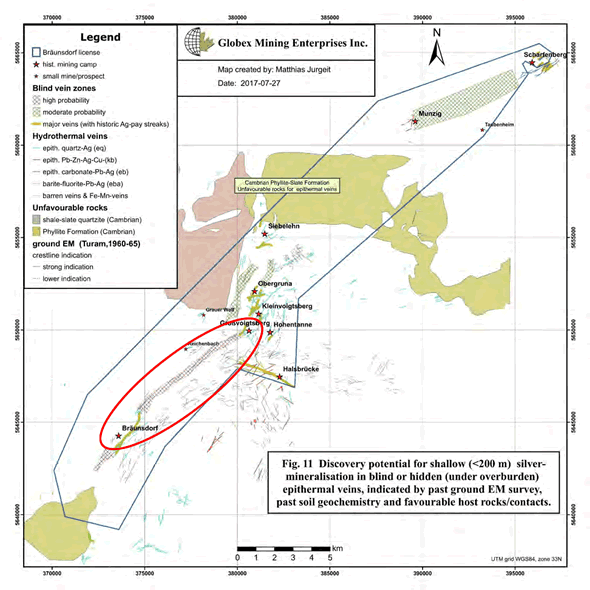
The underlying mining operations of both mines suggest that the silver veins continue in the direction of each other which could mean that there is a connection between the two properties and a potential deposit. The Bräunsdorf mine yielded almost 113 tonnes of silver in the past with a grade around 1kg/t Ag and the Großvoigtsberg mine yielded roughly 31 tonnes at a high grade of up to 3.5kg/t Ag, which could mean that a significant amount of higher grade silver might be in between.
An in-depth exploration study was never undertaken likely due to the presence of overburden on the 7 km stretch of land. However, past exploration results, dating back to the 1960s and 1970s, clearly indicated hidden (under overburden) epithermal veins (see map below).
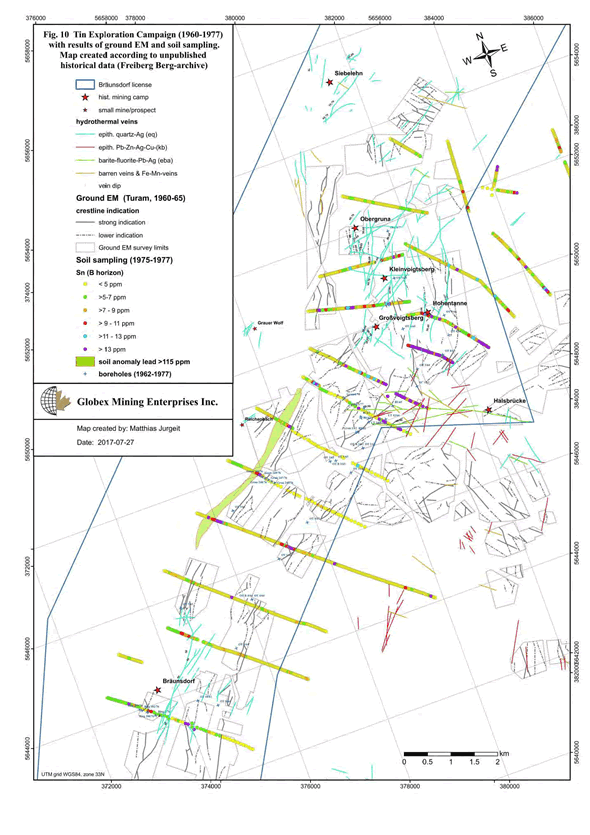
Another area of interest is around the aforementioned Munzig mining camp, which was never a fully operational mine due to the water supply issues, which are not likely to be a challenge anymore. While the grades of the deposits that were found in the 19th century were lower than in the rest of the area, the width of the vein was significant (up to 15 meters) and likely suggests further deposits.
While for now, these two zones might be attractive ones, given the scant exploration activity in the whole licensed area, Globex could easily discover previously unknown deposits.
Next Steps
Globex now has five years to fully explore the area with a possibility to extend its license or to transform it into a production license if the project ends up being successful. During the next three months Globex will focus on acquiring and studying more historical data, property visits, initial sampling and a possible airborne electromagnetic and magnetic survey. Thereafter, the Company will decide on ground exploration targets for 2018.
In the long-run, Globex can easily use its experience of partnering with different mining firms in order to advance the project, or to sell it for a royalty interest in order to optimize its return on investment.
Conclusion
Once again Globex shows why investors should pay close attention to what this smart project generator is up to. This German project not only further diversifies the Company’s portfolio of attractive properties, but due to the initial information that Globex obtained, one can already see that this is likely to be a promising endeavor.
Interesting is that the Company took a similar approach of exploring older mining properties in Canada where recent results look very encouraging. Finally, given the fact that the mining laws in Germany are somewhat similar to those in Canada, it is unlikely that anything unexpected should stand in Globex’ way to achieve similar results. Recommendation BUY.
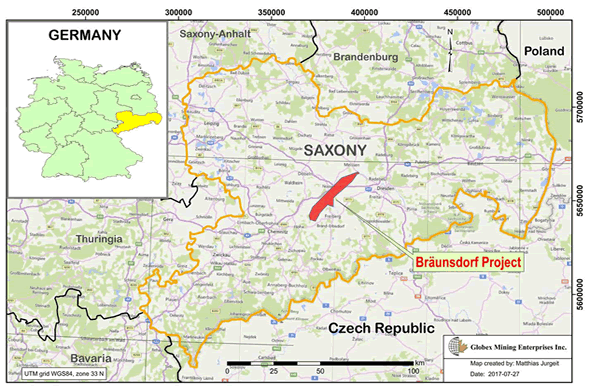
| Smallcaps.us Advice: Buy | Price Target: $2.87 | Latest Company Report (pdf) |
| For important disclosures, please read our disclaimer. | ||
